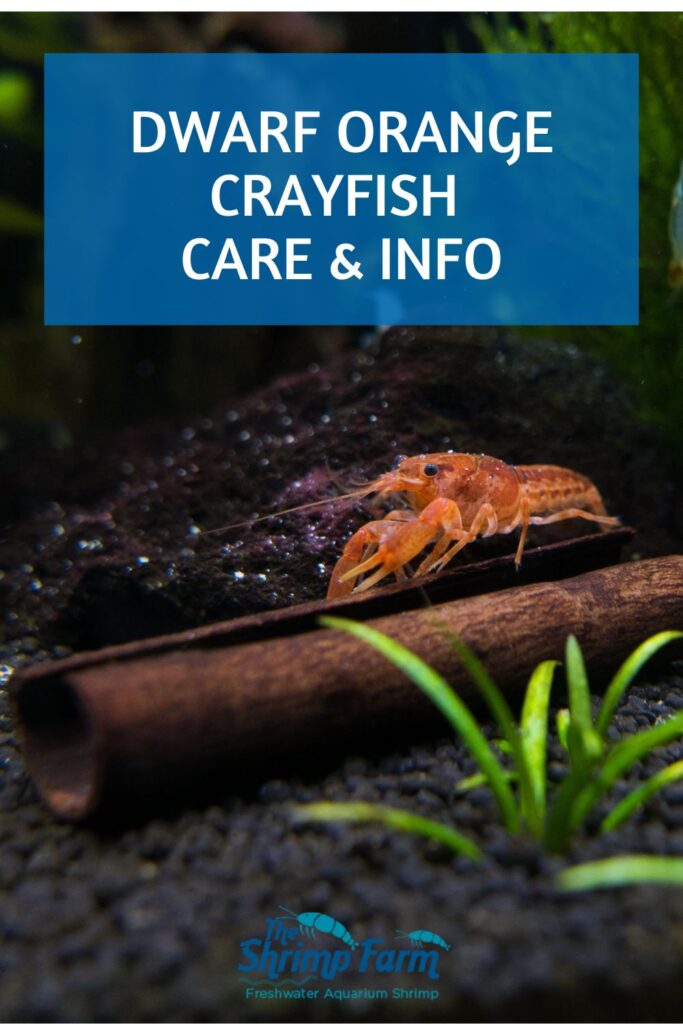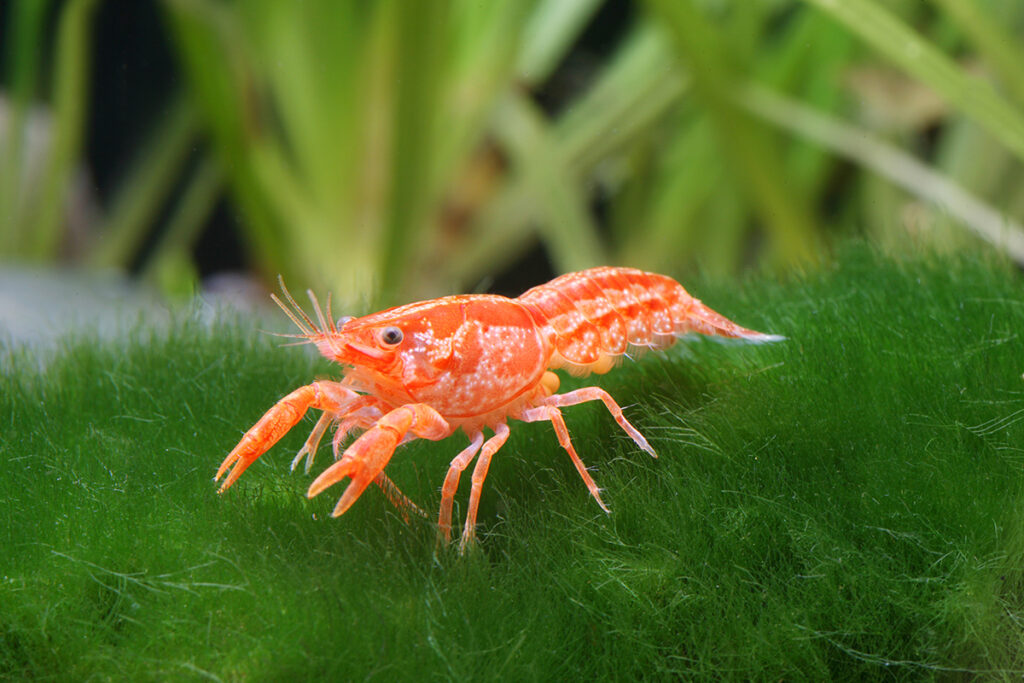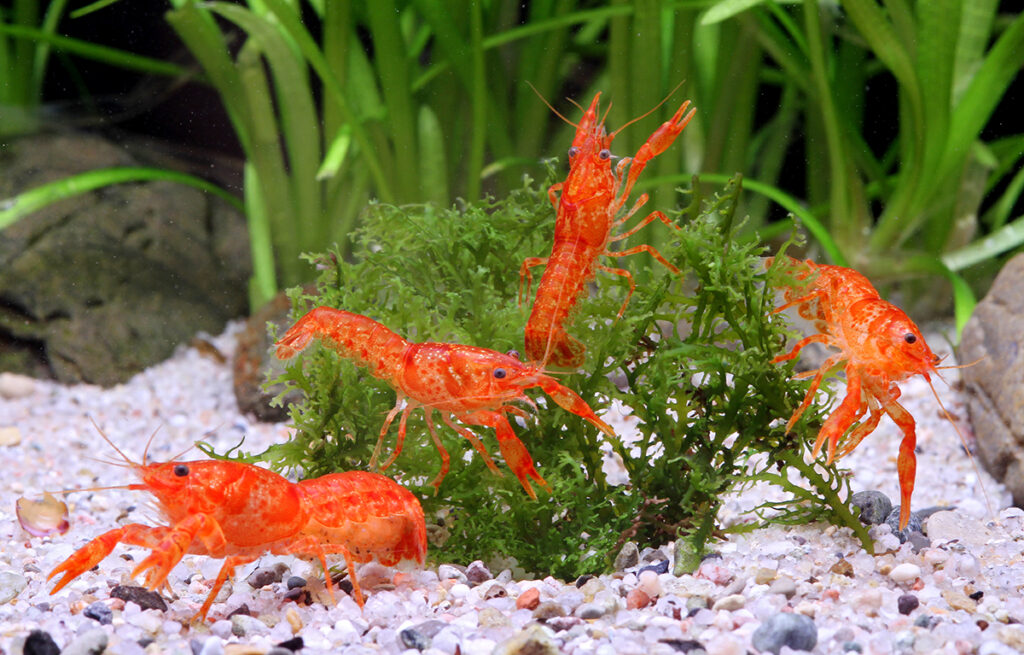Dwarf Orange Crayfish | CPO crayfish care & info
Cambarellus patzcuarensis 'Orange', also known as the dwarf orange crayfish or orange Mexican dwarf crayfish, is a dwarf crayfish species selectively bred for a striking orange color. These small crayfish are appreciated by shrimp keepers for their peaceful nature. They the perfect addition to a shrimp-/invertebrate setup or even a community tank.
Keep reading for everything you need to know about dwarf orange crayfish and keeping these crays in your own aquarium!
| Scientific name | Cambarellus patzcuarensis 'Orange' |
| Common names | Dwarf orange crayfish, CPO crayfish, Mexican dwarf crayfish |
| Difficulty level | Easy |
| Origin | Mexico |
Table of Contents
Orange dwarf crayfish natural habitat
The wild form of Cambarellus patzcuarensis is mainly naturally found in a lake called Pátzcuaro. I'm sure no one saw that one coming! Located in the state of Michoacán, this is a closed-off, high-altitude lake of volcanic origin. It's shallow (max. 39ft) and relatively warm.
Surrounded by wetlands, Lake Pátzcuaro is an important spot for local wildlife, including birds, various reptiles and fish, and of course the Mexican dwarf crayfish. Unfortunately, its water quality is currently considered pretty abysmal due to cattle ranching, raw sewage dumping and other threats.
As a result of this major habitat decline, and despite the fact that it's incredibly common in the aquarium hobby, Cambarellus patzcuarensis is currently considered Endangered by the IUCN.
Did you know? Like many other crayfish, this one, too, is a potential invasive species. They can survive in a wide range of water types as long as it doesn't get too chilly. In one study, it a group was found to have established itself in a thermal pool in Hungary. It was the orange color morph, too, not the tan wild color!
Setting up a dwarf orange crayfish aquarium
Requirements
At a maximum size of around 2 inches (5 cm), dwarf orange crayfish stay quite small. Contrary to their larger cousins, they do fine in small aquariums. Something around 10 gallons (38L) would be a great place to start.
As with all aquarium inhabitants, a filter is a must when keeping Mexican dwarf crayfish. Without it, the tank won't cycle and your livestock will be at risk. If you're considering breeding your crays, you might want to go for a gentle filter such as a sponge filter to prevent the fry from being sucked in. A heater is not a necessity if your tank is placed indoors and ambient temperatures are stable, but if this is not the case, you might want to consider one just to be sure.
Dwarf orange crayfish are prey animals that molt regularly. After molting the new exoskeleton doesn't harden right away, which means the crayfish is vulnerable. As a result, these inverts love to have plenty of hiding places in the aquarium. This way, they can retreat during molting to avoid any possible predators or aggressive fellow crayfish. Multiple hides per crayfish are recommended. Live plants or shrimp tubes should work well.
Water quality
Dwarf crayfish such as the dwarf orange crayfish aren't too fussy about water quality. You should usually be able to keep them without having to modify your tap water too much. This makes them a great option for beginners who don't have the experience to keep more fragile and expensive shrimp or crayfish yet.
This being said, as discussed earlier, Mexican dwarf crayfish do need a fully cycled tank. They don't deal well with ammonia or nitrite. Nitrate is less of a problem, but you should still do regular water changes to remove some of it (25% per week is a good place to start, but the exact frequency depends on factors like tank size and the amount of crayfish).
As always, the water values should be kept as stable as possible. Sudden fluctuations can easily prove fatal.
pH: 6.5-8.0
Temperature: 65-80 °F/18.5-26.5 °C
Hardness: 3-15 dkh
Tankmates
Crayfish in general are notorious in the aquarium hobby for their aggressive tendencies. Luckily, though, things are a little different with dwarf crays. Dwarf orange crayfish actually don't display aggression at all except during the occasional short territorial squabble with their own species. They can even be kept with shrimp! If you do spot your Mexican dwarf crayfish eating a shrimp or fish, then you can safely assume it was already dead.
When choosing tankmates for your dwarf orange crayfish, keep in mind that they aren't very large and might easily fall prey to hungry tankmates. Go for peaceful fish only and avoid anything that might be able to fit a crayfish in its mouth.
If you're planning on breeding your Mexican dwarf crayfish in the same tank, then it's probably a good idea to avoid fish altogether and only add other invertebrates like shrimp or snails.
Dwarf orange crayfish diet
Dwarf crayfish are omnivorous scavengers that will consume anything edible they come across. This makes them a good addition to your aquarium 'cleaning crew'. They will eat any leftover bits that your fish miss.
A varied diet is the key to a healthy Mexican dwarf crayfish. A high quality invertebrate food makes a good staple and contains the nutrients your crayfish needs to grow and molt successfully. I imagine a color enhancing food such as this one might be a nice option to go for, as it might also help maintain that bright orange coloration.
Supplement with anything you can think of! Frozen foods (mosquito larvae, bloodworms, brine shrimp), fresh blanched veggies, algae tablets, they'll happily devour it all.
Breeding dwarf orange crayfish
Breeding dwarf orange crayfish is not too difficult and a great option for the beginning breeder. If you have both males and females in your tank, breeding should occur soon enough. The male will pin the female down to mate, after which she 'saves' the sperm to later fertilize up to around 60 eggs. As with shrimp, these eggs will be carried between the back legs ('swimmerets') until they are ready to hatch.
If there are enough hiding places in the tank you don't have to provide any extra care. The young crayfish might spend the first few days after being released in hiding to prevent being eaten. This is nothing to worry about and they should come out to forage alongside the adults soon enough!
Frequently asked questions
Yes. These crayfish are peaceful and won't go after guppies' long fins like most other species would.
Buying dwarf orange crayfish
Mexican dwarf crayfish have become quite popular in the aquarium trade due to their peaceful nature and comical behavior. You should be able to find them at most aquarium stores.
If you don't want to leave the comfort of your home, The Shrimp Farm also sells and ships them right to your doorstep: you can find dwarf orange crayfish at The Shrimp Farm here.



 Shrimp
Shrimp Fish
Fish Crab &
Crab & Plants
Plants Foods
Foods Snails
Snails



3 Comments